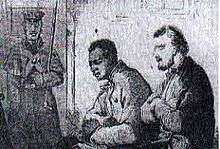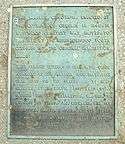Shields Green
| Shields Green | |
|---|---|
 Shields Green (center) awaiting his 1859 trial after the Harpers Ferry raid | |
| Born |
1836 South Carolina, U.S. |
| Died |
December 16, 1859 (aged 22–23) Charles Town, Virginia (now West Virginia), U.S. |
| Cause of death | Execution by hanging |
| Other names |
Emperor Esau Brown |
| Known for | Raid on Harpers Ferry |
Shields Green (1836?-1859), also known as "Emperor," was an ex-slave who participated in John Brown's unsuccessful raid on Harpers Ferry.[1] Though he had a chance to escape capture, he returned to the fighting and was captured with Brown. For their parts in the raid, Green and John A. Copeland were hanged on December 16, 1859, in Charles Town, West Virginia (then part of Virginia). Green may also have been known as "Esau Brown."[2]
Early life
Shields Green was born into slavery in South Carolina, where he was called Emperor. He escaped as a young man from Charleston, South Carolina, and made his way north to freedom in Rochester, New York.
The Harpers Ferry raid


Green first met John Brown at the house of the abolitionist Frederick Douglass[3] in Rochester. Later Green accompanied Douglass to Chambersburg, Pennsylvania, to meet Brown for discussions about his plans.[4] Green and Douglass met with Brown and John Henry Kagi at an abandoned stone quarry near Chambersburg. Douglass left after disagreeing with Brown on planning an armed attack on a Federal arsenal, but Green stayed to join the raiders.
Years later Douglass described Green in his memoir:
- "Shields Green was not one to shrink from hardships or dangers. He was a man of few words, and his speech was singularly broken; but his courage and self-respect made him quite a dignified character."[3]
During the raid, Green and others were assigned to recruit slaves from the nearby countryside to join the fighting.[2] According to Douglass, Jeremiah Anderson, one of Brown's men who escaped capture, said that Green could have escaped with him. "I told him to come; that we could do nothing more, but he simply said he must go down to de ole man."[3]
Green and Copeland were indicted, tried, and convicted with John Brown for treason against Virginia and other crimes, but did not say a word during the trial.[5] On the morning of John Brown's execution, Green sent word to Brown that he was glad to have fought with him and awaited his own execution willingly.[6]
Green and Copeland were hanged two weeks after Brown. After the execution, the cadavers of Green and Copeland were exhumed and taken to Virginia to the Winchester Medical College, for dissection by students in the anatomy laboratory. Professor James Monroe of Oberlin College, a family friend of Copeland from Oberlin, Ohio, searched for Copeland's body, but found Green's, and was unable to retrieve either body.[7][8] "We visited the dissecting rooms. The body of Copeland was not there, but I was startled to find the body of another Oberlin neighbor whom I had often met upon our streets, a colored man named Shields Greene."[9] Likewise the body of Watson Brown was also "claimed" by Winchester Medical College as a teaching cadaver for students-an action for which the College was burned to the ground by Union troops in the Civil War. Watson Brown was reburied beside his father in 1882.
Legacy and honors
- On December 25, 1859, a memorial service was held in Oberlin for Copeland, Green, and Lewis Sheridan Leary, who died during the raid.
- A cenotaph was erected in 1865 in Westwood Cemetery to honor the three "citizens of Oberlin." The monument was moved in 1971 to Martin Luther King, Jr. Park on Vine Street in Oberlin.[10] The inscription reads:
- "These colored citizens of Oberlin, the heroic associates of the immortal John Brown, gave their lives for the slave. Et nunc servitudo etiam mortua est, laus deo [And thus slavery is finally dead, thanks be to God].
- S. Green died at Charleston, Va., Dec. 16, 1859, age 23 years.
- J. A. Copeland died at Charleston, Va., Dec. 16, 1859, age 25 years.
- L. S. Leary died at Harper's Ferry, Va., Oct 20, 1859, age 24 years."
References
- ↑ John Brown: The Conspirators Biographies, accessed May 21, 2007
- 1 2 Connections with the Past: Reflections on John Brown, accessed May 21, 2007.
- 1 2 3 Frederick Douglass, Life and Times of Frederick Douglass: His Early Life as a Slave, His Escape from Bondage, and His Complete History to the Present Time, 1881, 2001 (Digital Scanning), ISBN 1-58218-367-8, pp. 387-391.
- ↑ "John Brown's Black Raiders", PBS, accessed May 20, 2007
- ↑ Life, Trial and Execution of Captain John Brown, 1859; accessed May 21, 2007.
- ↑ Hinton, Richard J. (1894). John Brown and His Men. Funk and Wagnalls. pp. 507–5088.
- ↑ "John Copeland: A Hero of Harpers Ferry" (text and audio versions), WCPN Radio, aired February 21, 2001. Retrieved August 28, 2014.
- ↑ Nudelman, Franny (2004). John Brown's Body: Slavery, Violence, & the Culture of War. UNC Press. ISBN 080785557X.
- ↑ James Monroe, Oberlin College Website, accessed June 4, 2007.
- ↑ Monument to the Oberlinians Who Participated in John Brown's Raid On Harpers Ferry, accessed May 21, 2007.